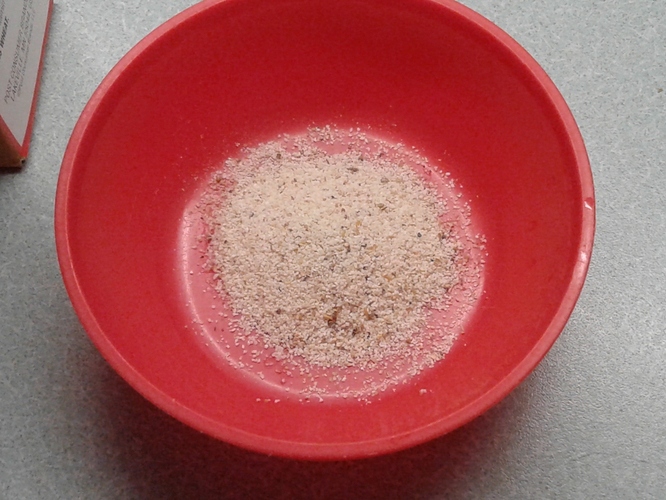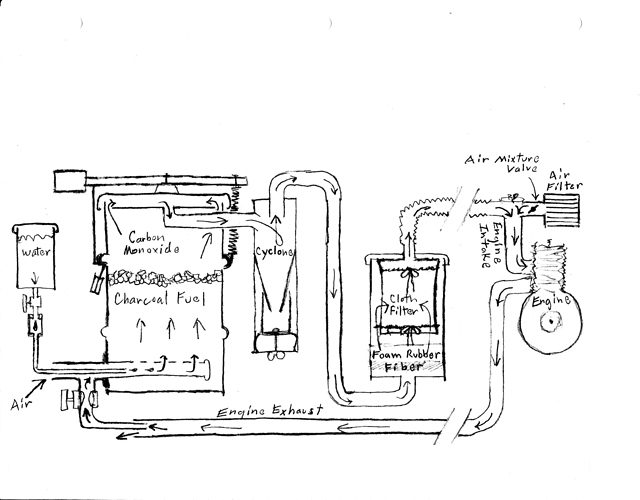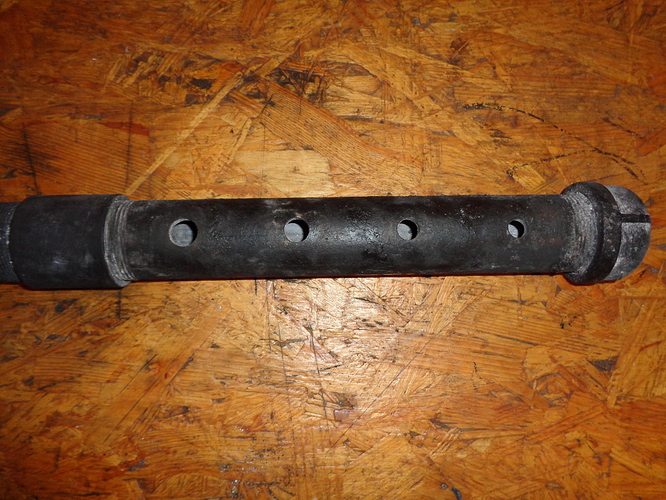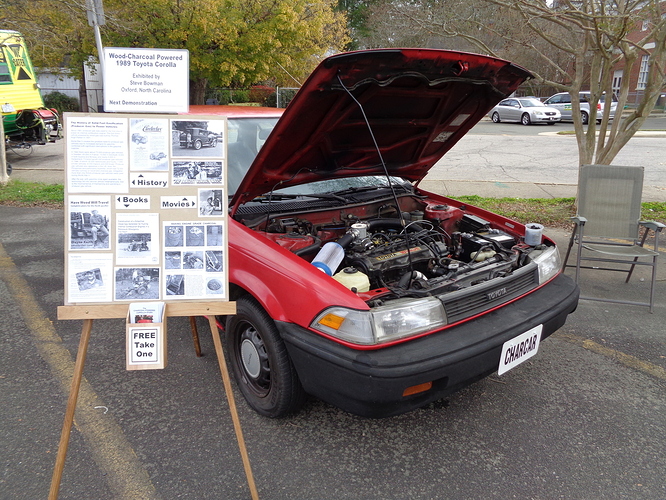Today I performed the annual grinding of 100 pounds of corn into corn meal and grits to give away for Christmas presents—this time using charcoal instead of gasoline to power the engine. It worked quite well. It took one and a half hours of run time. During the previous test run I discovered that I did not need to feed in exhaust gas to keep the reaction from getting too hot, so I only dripped in a little water to give a slight boost to the power. The gas stayed cool for the whole run which used about 2.5 pounds of charcoal for the 2 HP engine. Here is a short video:
Oh, what a nice build, do you get 3 different fractions on the corn?
Jan,
Thanks. Yes, I do. Corn meal comes out the bottom, grits between the two screens, and what I call “chicken feed” (which I regrind to produce more grits) comes off the top.
You are a craftsman in many terms! I wuld be honoured to get a pound of this for a christmas present more thain any bought thing! Your friends and family are lucky.
Since you mentioned grits, l have a funny anecdote to share. When me and JO were prepareing for our US trip this year, we were constantly hearing about how we will have the oppertunity to try grits, the famous Southern dish and l, being a coulinary enthusiast, was realy looking forward to this. When we finaly had the privilege to taste Mrs. Lisas grits at the Keith homestead, to much of my surprice, it was a dish l grew up on  its called gres here. however Lisa prepared them with broth l belive, but we boil them in milk and sweeten with sugar or honey, cocoa powder or cinamon.
its called gres here. however Lisa prepared them with broth l belive, but we boil them in milk and sweeten with sugar or honey, cocoa powder or cinamon.
One thing to mention thugh is grits is only reserved to wheat meal. Corn meal is called polenta.
Thanks very much for the video Mr. Steve .
I see a lot of excellent workmanship in the clip and seeing the fire makes me want to go out and burn some wood even if it is cold , wet and windy here today . On the other hand seeing the corn makes me want to stay inside and watch the wife make fresh corn bread .
Here is our American off the store shelf, made from wheat. It is a creamy smooth eating cereal. We all so eat it with milk or cream, with honey, brown sugar, or maple syrup. Cinnamon is also used too. Since 1919 Malt O Meal, made with wheat Farina, Malted Barley.
100 years of making the Northerners cereal.
The Southerners crits is good too.
Bob
On the rare occasion that I grind wheat to make whole wheat flour, I end up with some wheat grits which I have cooked like corn grits. It is good, too. I like grits with salt, butter, cheese and bacon bits mixed in–delicious.
Reminds me of shahi haleem, a great comfort food of Pakistan and India, perhaps elsewhere. Wheat meal, lentils, spices, slow cooked with meat till the meat falls off the bones.
Some versions call for barley, I have a hulless brown barley which should be perfect. Fortunately it can be found in prepared packages here too. Little known, but I love it.
Since my vocation was in commercial printing, I designed commercial style packaging for my non-commercial products.
I decided to do an update on the brochure I give out at shows when exhibiting the Corolla. Included is an updated drawing. Eddie’s drawing, which I have used until now, includes many more construction details, but doesn’t show some of the latest modifications to the cyclone and filter.
I didn’t drive the Corolla any in February or March, so I decided it was time to fire it up and go for a ride. I decided to drive it on my DVD delivery route, to the homes of a few elderly church members who do not have internet access of our currently on-line only church services. The car started instantly and ran great. It’s nice to be able to enjoy the fruits of my labor.
One more comment: I rejoiced recently when my notice for registration renewal on the Corolla indicated that no vehicle inspection was required. I thought it had to be 35-years-old, but apparently vehicles over 30-years-old no longer have to be inspected in North Carolina. Yeah!
When I have demonstrated my charcoal-powered push mower at antique engine shows, I have done demonstrations once each hour or so; starting it with the blower and letting it run 5 to 10 minutes. The hit-and-miss engine guys run their engines so slow they almost stop, but they are able to have a continuously operating demonstration which can run all day. Most people are not going to go back to an exhibit later if they missed the demonstration the first time they pass by, so I decided to consider a continuous run. Today I did an experiment to see how long the mower would run on one fill of charcoal. This experiment took much longer than I anticipated—which is a good thing. The longest previous run while mowing thin grass was 1-1/2 hours. Today it ran over 6 hours at idle speed and no load other than spinning the blade. The reactor is a 5 gallon open-head steel bucket. It used about 2 gallons volume of charcoal or just over 2 pounds. After about 6 hours I’m ready to head home anyway.
I really like your Corolla project and would like to eventually copy several aspects of it, particularly the 30 gallon Simple Fire drum with the Leitinger nozzle. One of the logistical problems that I have to solve before I start my build is figuring out my supply of charcoal. I was wondering, how far can you drive on 30 gallons of charcoal? How far does a single batch of charcoal made in your 55 gallon drums get you?
Aaron,
Thanks for your interest. I can get about 30 miles of continuous open road driving before having to refill. All of my trips have been 30 miles or less, so I don’t yet know how much further I could go on the refill of a hot system. This means a consumption of about 10 gallons by volume of charcoal, 11 to 12 pounds, 3 miles per pound before having to refill. What happens to the other 20 gallons of charcoal? The nozzle, outlet pipe and diffuser plate, perhaps take up 5 gallons of space. Some charcoal is used as insulation around the nozzle and reaction zone, to protect the barrel from melting. Finally, there must be charcoal above the reaction zone to contain it so the oxygen will not escape before the reaction to carbon monoxide takes place. The charcoal above the reaction zone also does some filtering of the gas.
It is time to refuel when the reaction zone breaks through the top of the charcoal in the drum and the gas quality drops. At that point the gas temperature greatly increases, creating various problems. The 30 and 55 gallon drums are not the ideal proportions, but are easy to work with. It would be better if the reactor were a bit smaller in diameter and taller. Taller gives you more run time. Charcoal size and density also affect the run time. For example charcoal made from the heart wood of oak is more dense and would give a longer run time. What I use is probably mid-grade to low grade most of the time. Low is about 16 ounces per gallon volume, mid-grade is 20 ounces and premium is 24 ounces. These are my own labels and specifications.
It has been a fun project. I drive it once every week or so. My main concern is that I know the head mechanic on this project all too well to feel comfortable driving something he (me) worked on. 'Cause I know he doesn’t know what he’s doing. Ha! Ha! So far, I’ve always made it back home—usually under charcoal power.
Nozzle Update: Today I cleaned out the gasifier in the Toyota. It has been 10 months and 255 miles since the last cleanout. I was pleased to see that the nozzle still shows no deterioration. Take a look:
There was a lot of porous clinker material over the smallest hole on the right which is opposite the air and water intake end. I suppose that means that the reaction was hotter on that end. Any thoughts? Perhaps the steam is all sucked up through the first three holes?
The gasifier continued to perform well through the last run yesterday. The only odd thing, which I reported on another thread, has been that I have had to close the air valve more the last few months. It may be that the small hole nozzle was not functioning. I’m hoping the air adjustment will be back to normal now. We’ll see. One recent change in operating procedure is that I have increased the water drip slightly and stopped using exhaust gas. Next cleanout, we’ll see if that has had any long term effects on the condition of the nozzle.
How does that time frame compare to the time frame of more water and no exhaust?
Don, I have needed to nearly close the air valve for proper mixture for at least 4 months, but have only been driving without exhaust gas for 3 weeks.
Greetings all,
I cleaned out the Toyota gasifier a month or so ago. A week or two later I was going on a longer than usual drive, my first which would require a refueling so I could see how it performed after refueling. I didn’t even make it out of town before the timing belt broke. A couple of weeks later with timing belt and water pump replaced it was running again–quite a job for someone who is not an auto mechanic. Today I went by the Toyota place to pick up a couple of small parts they had ordered for me, but forgot to turn off the water drip when I arrived. An employee walked up as I was getting ready to leave the building and expressed interest. When I went out, steam was pouring from the air inlet and two mechanics were there observing. All that steam made for an embarrassing show. The mechanics seemed impressed in spite of my flub. I explained some and gave them a brochure to tell the rest of the story. It took a good while to get the engine started even with the blower running, whereas normally I could have started it on gas still in the system. When the engine finally started, it ran well and off I went. It was a good trip except for the steam incident.
It seems that the air mixture adjustment has returned to the normal position. Some may remember that before the cleaning, I had been running it with the air valve nearly closed. Apparently dust and clinker had partially blocked the nozzle holes, creating a restriction and throwing off the air/gas balance, from what was normal.
Steve, I think most of us can testify strangers and woodgas is not a good combination.
A workmate of mine rides with me almost every day, 20 miles a day. I can’t recall we’ve had a single incident in years. If I were to pick up a stranger there’s probably a 50/50 chance something will go wrong 
Lightup in an hour. Going to the paper mill for an 11 hour night shift. Entering winter time will make the clock turn 2 am two times 
Went to a very small car show in the closest town today—perhaps 25 cars. Not a lot of people there either, but a lot of interest in the CharCar. After my first car show over a year ago, I decided to improve my display by getting it out from under the hood and placing it on an easel. I think it looks better. Here are a couple of photos:










